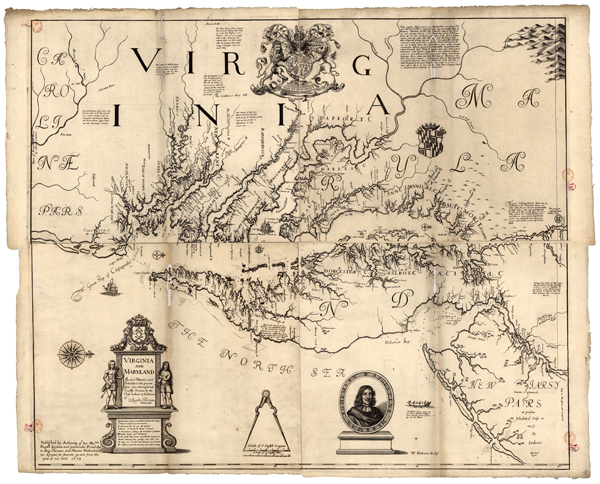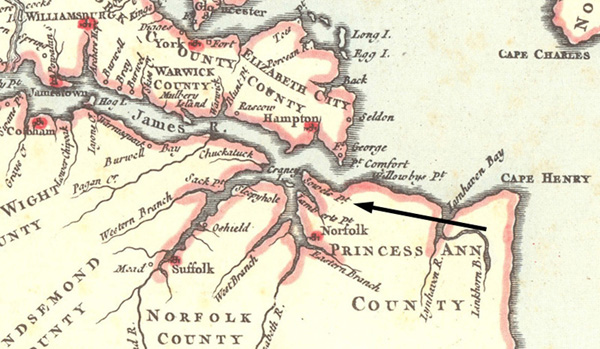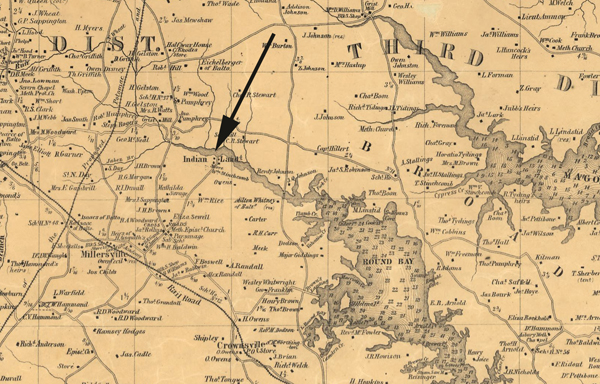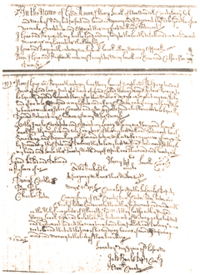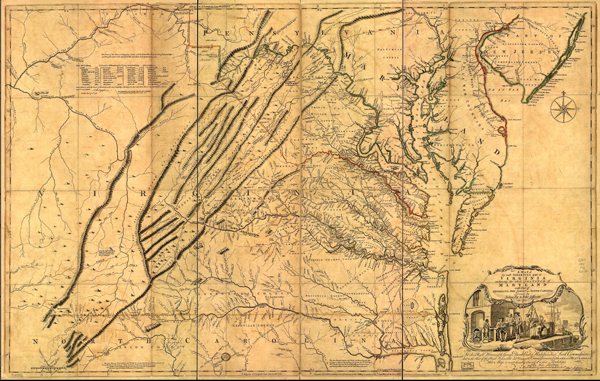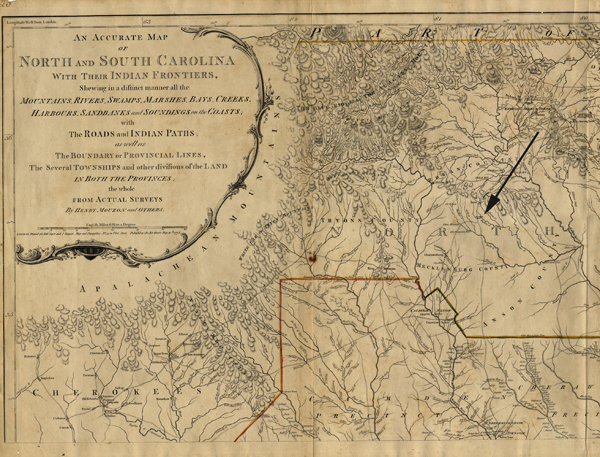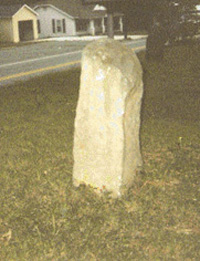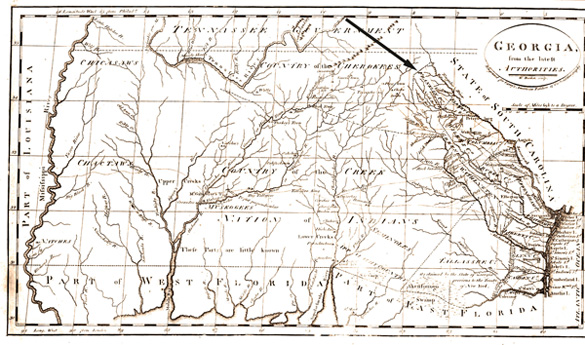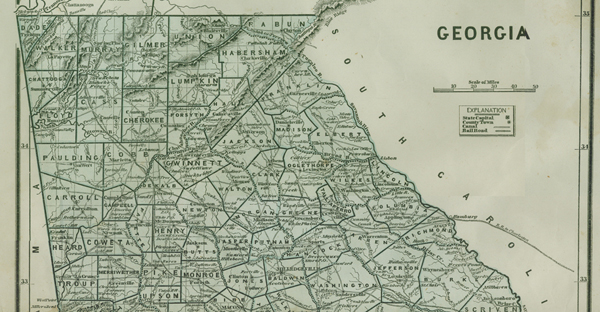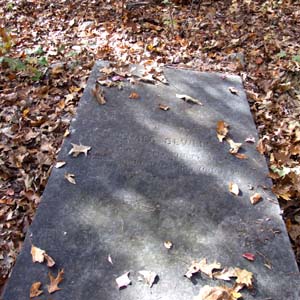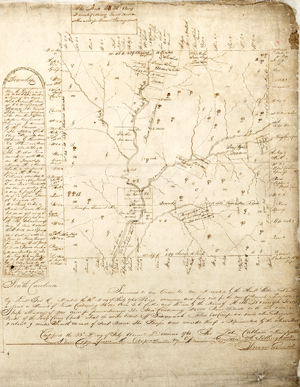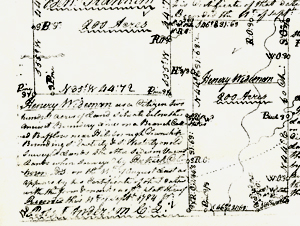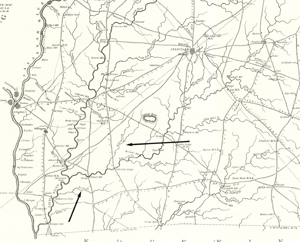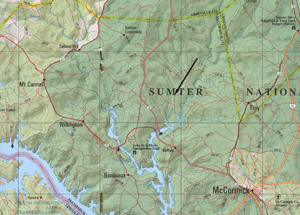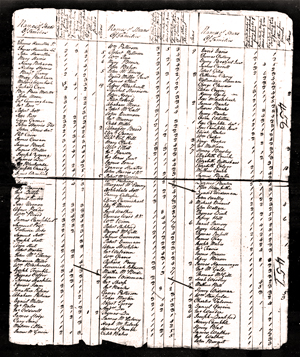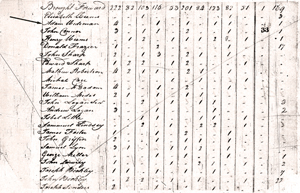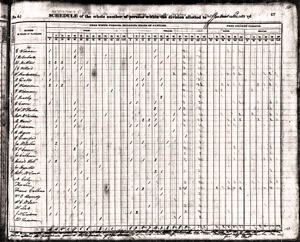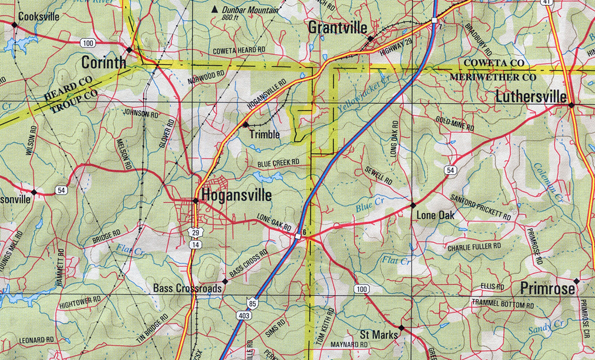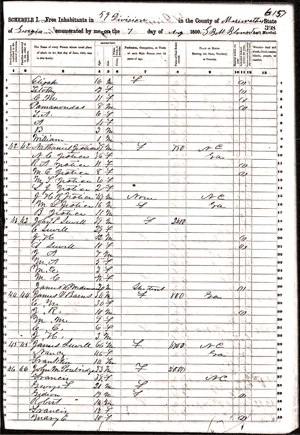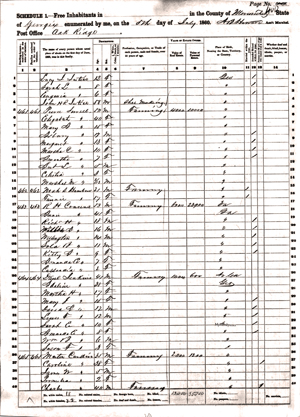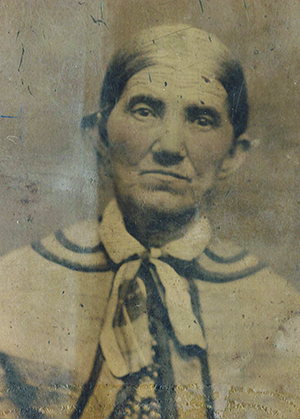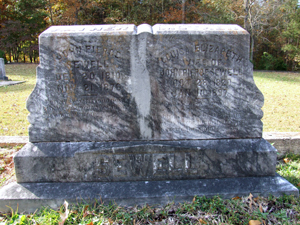John Pierce Sewell (1810 – 1876) married Louisa Elizabeth Wideman (1820 – 1897) in Troup County, Georgia, in 1837. He was part of a seventh generation of Sewells in America, with maternal and paternal descent from the earliest English settlers of the Virginia colony in the seventeenth century.[1] Most of Louisa's ancestry was English as well, but her father's paternal grandparents were among those who fled Germany during the turmoil of the Seven Years War, arriving in South Carolina in the early 1760s.
The Sewells
The progenitor of the Sewells in the Georgia Piedmont in the nineteenth century is thought to have been one Henry Sewell (c. 1604 - 1646/47), but certain proof of that has not been located. He was born somewhere in the English Midlands, probably in the first decade of the seventeenth century. He emigrated to the new Virginia colony in the 1620s and settled on the eastern shore of the Elizabeth River as it empties into the James River just west of Cape Henry. The original Jamestown colonists had first landed nearby in 1607, but, as instructed, they soon sailed forty or fifty miles further up the James River to found their new colony. As the colony at Jamestown established itself, settlers began populating the rest of the Tidewater, and among them was Henry Sewell, who gave his name to the point of land between Willoughby Bay on the east and the Elizabeth River on the west. In 1907 Sewell’s Point was the site of the Jamestown Exposition celebrating the 300th anniversary of the founding of Jamestown. Ten years later, Sewell’s Point became the site of what is today Naval Station Norfolk, the world's largest naval base.
|
Figure 1. Augustine Herrman's map of Virginia and Maryland, 1670. The mouth of the Chesapeake Bay and Norfolk, where Henry Sewell first settled in the 1630s are at left; Anne Arundel County, Maryland, where his son settled in the 1660s, is at upper right. |
Henry Sewell
Henry Sewell’s wife, Alice (1608 -1644), who he married in Virginia around 1631, was probably the sister of Capt. Thomas Willoughby, member of the Virginia House of Burgesses between 1628 and 1632 and a large landowner in the area. They had three children: the oldest, whom genealogists often refer to as Henry II, was born in 1632; a daughter, Anne, born about 1635; and another son, whose name has not been found and who died as a young man without having children.
Henry owned approximately 150 acres on the western side of Sewell’s Point. When his estate was finally settled in the 1660s, it was described in court documents as being “ye tract or dividend of land called by ye name of Sewell’s Point and situate lying and being as above mentioned, viz., all ye buildings, orchards, privileges and appurtenances whatsoever thereunto belonging . . . . ”[2] Tobacco was one of the primary exports in the early economy of Virginia, and Henry Sewell himself made a fortune in the tobacco trade. An account in 1638 showed Sewell with cargos of sassafras root and tobacco worth over £650 or more than $80,000 in today’s dollars.[3] As a result of his standing in the community, Henry Sewell was a delegate to at least three sessions of the House of Burgesses, and when population growth in the area led to the creation of a new parish along the Elizabeth River about 1637, Henry Sewell was among the founding members of the first church in the parish, which was built at Sewell’s Point in 1641.[4]
Sometime in late winter, probably in February, 1644, both Henry and Alice Sewell died, whether by disease or accident is not known. On 20 February 1644, the Court ordered that “Mr. Matthew Phillips, the Administrator of Mr. Henry Sewell, deceased, shall within ten days satisfy and pay to Mr. Thomas Harrison, clerk, one thousand pounds of tobacco, and satisfaction in consideration for the burial and preaching of the sermon of Mr. and Mrs. Sewell, deceased, and for breaking ground in the chancel of the church for the burial of Mr. and Mrs. Sewell.”[5]
The oldest of the Sewells’ three orphaned children, Henry II and Anne, grew to adulthood under the care of their uncle Thomas Willoughby and others, while the youngest of the three was sent to school in England under the care of a family friend, Thomas Lee. Anne married Lemuel Mason sometime in the 1650s and in the early 1660s, her brother Henry moved to the Severn River in Maryland, where a number of his old neighbors from around Sewell’s Point had moved in the early 1650s.
|
Figure 2. Detail from Fry and Jefferson’s "Carte de la Virginie et du Maryland," 1755, showing "Sowels Pt.," annotated with an arrow to locate Sewells Point. (Library of Congress) |
Henry Sewell II and Johanna Warner
Henry Sewell II first came to the Severn River in Anne Arundel County, Maryland, as a surveyor and, in August 1664, was granted a hundred acres in the Middle Neck Hundred on the south side of the Severn River, a grant “due him for transporting himself and William Rinthall into the Province.”[6] In 1673, he married Johanna Warner, daughter of his neighbors James and Elizabeth Harris Warner. His father-in-law died that same year, leaving a substantial estate to his widow and, after her death, to their daughter Johanna Sewell. Henry and Johanna’s first child, Henry III, was born at Warner’s Neck around 1675.
|
Figure 3. Detail from Simon Martenet's map of Anne Arundel County, Maryland, 1860, showing upper Severn River. Indian Landing was a prominent landmark in the area in the seventeenth century. The Sewells lived east of the crossroads around which the village of Millersville, Maryland, emerged in the nineteenth century, probably marked by "Eliza Sewell" annotated with the arrow on this map. (Library of Congress) |
Johanna Warner died giving birth to their second child, James, a year or two later, but Henry soon remarried and with his second wife, Elizabeth, whose maiden name may have been Baker, had five more children. In September 1680, Henry Sewell was granted a tract of land “[l]ying on the north side of [Severn] River, standing on the East side of a Cove called Sewell’s Cove, containing and now laid out for five hundred acres of land more or less. . . in a tract of land known by the name of Henry’s Increase, lying and being on the north side of . . . Severn River.”[7]
Even in the 1680s, the shores of the Chesapeake Bay were dangerous and, although there was not a repeat of the terrible massacre in the spring of 1644 that killed over 500 Virginia colonists, Indian attacks were still feared. Vivid proof of that is found in the records of the Maryland council in 1681, reporting the robbery committed by dozens of Indians on the Sewells’ neighbor John Marriot and his family, who lived on the south or western shore of the Severn River. Among the Marriot children was the future wife of Henry Sewell III.
The occasion of my present presumption is to inform your Lordship of a robbery committed by the Sinnequain [Seneca] Indians (as is supposed), on the first day of this instant, at the house of John Marriott at the head of Anne Arundel [Severn] River, upon the Ridge formerly Peter Porter’s. The enclosed was sent to me and the same day being our election day, I gave me the following narrative, viz.: That nine Indians came to his house, September 1st, inst. in the morning and pressed hard for entrance to his house, which he resisted, taking his gun in hand and standing upon his guard, willing his wife to take the children and make escape to the nearest plantation, which was hindered by more Indians, till then indescerned [sic], but still appearing more and more, to the quantity of one hundred or thereabouts. They then pressed so sore upon him that into the house they would go; no threat or sign of anger would deter them. Out of which they have carried all that he hath in this world, and killed his hogs, which he says he had thirty in his pen, which troubled his cornfield, some of which they have taken away, others they have killed for pastime and let lye, that of numbers he finds only three or four alive. His cattle he knows not what they have killed for they have all forsaken the plantation. His tobacco, which was hanging in the houses, they have thrown down and spoiled. All of which tendeth to his great loss, and putting the neighboring plantations in great feare, so that there are many of them gathered together for their future safety.[8]
Henry and Elizabeth Sewell must have been relatively prosperous, and by the time he died in November 1699, he owned at least 1,400 acres of land around the upper Severn River northwest of Annapolis. How much of this was cultivated in tobacco isn’t known, although it is almost certain to have been as much as he could grow.[9]
|
Figure 4. Will of Henry Sewell, father of Samuel Sewell Sr., Anne Arundel County, Maryland, 1726. |
Henry Sewell III and Mary Marriot
The year after his father’s death, Henry Sewell III married Mary Marriot, daughter of neighbors John and Sarah Acton Marriot. Sarah’s father, Richard Acton, had been among the group that emigrated from around the Elizabeth River in Virginia to the Severn River in Maryland in 1651. Henry and Mary Sewell had six or seven children, not all of whom lived to adulthood and, of those that did, most of their lives are obscure. Not so with one of their younger children, Samuel, born in Maryland on 2 May 1715, who would be the ancestor of the numerous Sewell families in Georgia in the nineteenth-century.
In September 1707, Henry Sewell III paid £40 for a hundred acres of “Howard and Porter’s Range, with houses, edifices, gardens, etc.” and located on a ridge above the Severn River, near property that he had inherited from his father. The property lay somewhere east of the present intersection of Patuxent Freeway and I-97, twelve or so miles northwest of Annapolis and appears to have remained their home for the rest of their lives. Henry Sewell III died in May 1726, dividing some of his estate between his sons but leaving his widow a life estate in their home plantation at Howard and Porter’s Range. His estate was valued at £128-9s-11½p and included a “a parcel of old books, 2 guns,” and a servant, Moriah Wells, who was likely an enslaved African-American.
Henry’s death left his widow still with several children to raise, the youngest only six or seven years old. With help from her older children and their numerous Sewell and Marriot relatives no doubt, Mary Sewell continued on the family’s plantation until her death around 1753, and it is believed that her son Samuel continued to live on the home plantation as long as she was alive. Sometime after her death, Samuel uprooted his family from the place where three generations of Sewells had lived for nearly a century and relocated to North Carolina.
Samuel Sewell Sr. and Christian Stover
Samuel Sewell apparently delayed marriage until he was in his early thirties, perhaps because he bore the primary responsibility for his mother and the family plantation after the premature death of his older brother Henry around 1732. Whatever the reason, it was not until 17 February 1747/48 that he married Christian Stover. She is thought to have been born in Pennsylvania around 1717 and may have been the daughter of Jacob Stover and his wife Sarah Boone, but that has not been proven.[10]
|
Figure 5. Fry and Jefferson's map of Virginia and Maryland in 1751, around the time Samuel Sewell Sr. and his family were moving to North Carolina. This map shows the arc westward of the Great Philadelphia Waggon Road from Philadelphia, at upper right in this image, down through the Valley of Virginia to the Carolina Piedmont, lower left, the route followed by many of those that settled the Carolina Piedmont in the third quarter of the eighteenth century. (Library of Congress) |
Samuel and Christian Sewell’s first child, Samuel Jr., was born 17 January 1749/50, probably at the family plantation on the Severn River. He was followed by seven more sons before their last child, a daughter named Comfort, was born in 1767. By then, however, they were no longer living in Maryland. Because of flaws in wills through two generations, Samuel’s inheritance was only twenty-five acres and the title to that was not even secure. He is thought to have acquired other land in Maryland on his own, but for many of his generation, the pull of the new frontiers to the south and west must have been strong. Tobacco culture was notorious for wearing out the land, but for whatever the reason, as early as 1753 and certainly by 1760, he was among a number of Marylanders who relocated to the new lands that were opening up in the Carolina Piedmont at a time when the Yadkin River valley marked part of the nation’s Southern frontier.[11]
Most likely the Sewells had traveling companions on a journey that would have taken many weeks to complete, and some traditions say that Samuel Sewell, Absalom Baker, and their families left Anne Arundel County at the same time. Most likely they took the well-traveled Great Philadelphia Wagon Road that stretched westward from Philadelphia and crossed the Potomac River at Williams Ferry in western Maryland. From there the road continued in a southwesterly direction through the Valley of Virginia to the Staunton River gap in the Blue Ridge Mountains and then in a more southerly direction winding its way down through the Piedmont of North Carolina. Fry and Jefferson’s map of 1751 was the first to show “The Great Road from the Yadkin River thro Virginia to Philadelphia distant 455 Miles.” It was later known as the Great Philadelphia Wagon Road or simply the Great Wagon Road, although it was very late in the colonial period before wagons were actually able to traverse most of its length. In the years before the Revolution, this road brought a flood of white settlers into the southern Piedmont. Although some did follow the paths and roads that ran along the fall line through Virginia, that way required numerous river crossings, and the Sewells probably followed the majority of the back-country pioneers and took the Great Wagon Road, joining it in western Maryland and from there for the most part walking with their wagons and household goods to the Yadkin River.
|
Figure 6. Detail from Mouzon's map of North Carolina in 1770, annotated with an arrow to indicate approximate location of where Samuel Sewell Sr. and his family settled near the Great Wagon Road crossing of Buffalo Creek, southwest of Salisbury. A short distance further on, the ancient Cherokee trading path cut off to "Charlotteburg" and the southwest. (University of North Carolina) |
In Fry and Jefferson’s map, the Great Wagon Road is shown ending at the Yadkin River in the Moravian settlement at Wachovia, but the Sewells were among those who pushed on across the Yadkin, extending the Great Road further to the south and southwest. Later maps carried it across the Yadkin to Salisbury, where the road split into several branches leading to Charlotte, the Cherokee country, Camden Town in South Carolina, and Augusta, Georgia. The Sewells eventually settled on Irish Buffalo Creek southwest of Salisbury, North Carolina. Among their neighbors were the Plasters and the Bakers, who also had roots in Maryland and who would, like the Sewells, help settle the Georgia Piedmont in the early nineteenth century. Their home sat not far from the Great Wagon Road, somewhere north of the bridge over Buffalo Creek and a few miles northeast of where the “Path to the Cherokee” forked off to the southwest.
|
Figure 7. Stone marking the grave of Samuel Sewell Sr. at Kannapolis, North Carolina. |
Christian Sewell died in 1775 and was buried in the nearby Baker family cemetery, which would be incorporated into the city cemetery of Kannapolis, North Carolina, in the late nineteenth century. Samuel Sewell soon married Elizabeth Baker, who must have been decades younger than him, and with her had four or five more children. She was likely a relative of Absalom Baker, perhaps his sister.
During the American Revolution, Samuel Sewell Sr. was too old for active duty, but all of his and Christian Sewell’s sons have records of service in the American Revolution. Samuel Sewell died in the spring of 1789, apparently within days of the birth of his last child, and was buried beside his first wife in the Baker family cemetery. Over the next decade, all of his children left North Carolina, all but one of them destined for Georgia and most of those for Franklin County in northeast Georgia.
Samuel Sewell’s will left his widow a life estate in their plantation and stated, “It is my will and pleasure that my negro fellow Samuel shall stay in my plantation during the life of my wife Elizabeth to help raising my five youngest children and if it should please God to spear [sic] him, then, to be sold and the money price of him to be equally divided amongst my children.” After Elizabeth’s death, the estate was to be divided between his son Nicholas by his first marriage and with the four children he had with Elizabeth. The older children had presumably already received some inheritance as they married and started their own families.[12]
Samuel Sewell Jr. and Christian White
Samuel Sewell Jr., the oldest of Samuel and Christian Stover Sewell Sr.’s thirteen children, was born at the Sewell plantation on the Severn River in Anne Arundel County, Maryland, in February 1750. He may have been as young as three or four when the family moved to the North Carolina piedmont, and he was still just a boy during the French and Indian War, which included some fighting with the Cherokee in western North Carolina. As a young man in the early 1770s, he was probably keenly interested in the rising tensions between the American colonists and Great Britain.
It is believed that Samuel Sewell Jr. served in the Revolution in North Carolina, but the only record for “Samuel Sewell” in the roster of North Carolina veterans shows him having enlisted at Wilmington. If that is Samuel Sewell Jr., there is no other documentation that would explain why he enlisted there and not with his brothers Christoper and William in Salisbury.[13] Where they fought is not clear either, but it was quite likely that Samuel and at least some, if not all, of his brothers fought at the Battle of Kings Mountain in October 1780. Fought only a hard day’s march to the southwest of Rowan County, the battle lasted barely an hour but proved to be a turning point in the war. Thomas Jefferson himself proclaimed the Patriot victory at Kings Mountain "the turn of the tide of success." A year later, Lord Cornwallis surrendered his army at Yorktown, the last major battle of the war.
If Samuel did fight at Kings Mountain, he would have almost certainly returned home within days to be with his wife and infant daughter. He had married Christine White (1759 -1822) in February 1780, three weeks before the birth of their first child, Mary. A second child, James Lee Sewell, was born in the fall of 1783, three weeks after signing of the Treaty of Paris brought a formal end to the Revolutionary War.
There is no evidence that Samuel Sewell was anything more than a prosperous Southern planter, probably cultivating tobacco using slave labor. The family was still in Rowan County when James was born, but they had no doubt heard about the generous land grants that Georgia began issuing that fall, and by the time their next child was born in November 1785, they were in Georgia.[14]
Beginning in the 1720s, the native Cherokee were gradually forced off their lands, and by 1777, they had given up nearly all of their lands in Virginia, Kentucky, and the Carolinas. That same year, the first of several treaties that would gradually strip them of their lands in Georgia was signed as well. Wilkes County, one of Georgia’s original eight counties, was organized out of the Indian land cession of 1777, and there is some evidence that Sewells were among the earliest settlers there. In May 1783, the Cherokee were forced to cede yet another huge tract of land in Georgia, north of the Broad River between the Oconee River on the west and the Tugalo/Savannah River on the east. Out of that cession was organized Franklin County in early 1784, and it would soon become home to an extended family of Samuel Sewell Sr.’s descendants running through several generations.
In 1783, the state began its so-called headright grants of 200 acres of land per family, plus 50 acres per person, to anyone willing to migrate to Georgia, build a house, and start cultivating the land. Bounty grants, which were similar, were granted to individuals based on service in the Revolution or, among other things, outright fraud. In May 1784, a near-riot erupted over the issuance of grants in Franklin County and in July the grants were suspended entirely. Samuel Sewell received grants in Wilkes County in 1784 and again in 1786 and perhaps in Franklin County as well. It is believed that he and his family moved to the county around that time.[15]
The Sewells’ third child, John, was born in 1785, at a time when there was still much disorder on all along the Georgia frontier as the native Creek continued to contest for their land and make raids into lands already ceded. In 1787, a band of Creek killed eighty settlers, captured many more, and virtually destroyed the town of Greensboro, less than sixty miles south of Franklin County. And although the Cherokee were generally more peaceful, the boundary with the Cherokee Nation remained only thirty miles to the northwest for another forty years.
|
Figure 8. Detail from Barker's map "Georgia from the latest Authorities," 1794, annotated with an arrow to locate Franklin County, where the Sewells settled in the late 1780s. (Hargrett Library, University of Georgia) |
The Sewells’ fourth child, Nicholas, was born in the fall of 1790, just as the nation’s First Federal census was being compiled. Unfortunately, the Georgia schedules for all the Federal censuses before 1830 have been lost, although tax digests, deeds, and court records provide a few details. Three more children were born—Rachel in 1792, Samuel III in 1798, and the last, Isaac, in 1801. Where they lived at that time is not certain, but in 1804, Samuel Sewell bought land on the North Fork of the Broad River and built a house that would remain in the family for generations.[16]
In Georgia, the War of 1812 was experienced mostly in the form of the Creek War that broke out in the summer of 1813 after Creek warriors attacked and destroyed Fort Mims in southern Alabama, killing as many as 500 Americans. The attack struck fear through the Georgia frontier, and General John Floyd soon raised the state’s militia, perhaps 3,000 strong. Assembling at Macon, they established a fort on the lower Chattahoochee before moving into Alabama. Several skirmishes followed before the Creek dropped back to Horseshoe Bend, where they were decisively defeated by Andrew Jackson in March 1814. Some of Samuel and Christine Sewell’s sons probably enlisted for the typical six-month period, but it is unclear which ones.[17] The treaty ending the war was signed on Christmas Eve, 1814, and ratified by Congress on 16 February 1815.
Two days after the treaty ending the War of 1812 was ratified in Washington, Samuel Sewell Jr. died at his home in Franklin County, Georgia, a few weeks after his 75th birthday. He was buried in the family cemetery off what is now Highway 59 southwest of Lavonia. His widow, Christine Sewell, and two teen-aged sons, James and Nicholas, were still living at home when he died. In his will, his sons received a portion of the home place, with the remainder split between his widow and his daughter, Mary. His widow also was willed “the negro girl.” Other land, some of it in Madison and Elbert counties, was distributed among all five sons.
|
Figure 9. Detail from Morse and Breese's map, "Georgia," 1842, a time when descendants of Samuel Sewell Sr. were helping settle the western Georgia Piedmont. Meriwether County is at lower left; Franklin County at upper right. (Image scanned from original map in author's collection) |
James Sewell II and Mary "Polly" Baker
Repeating his father’s experience, James Lee Sewell may have still been an infant when his parents moved from Rowan County, North Carolina, to Franklin County, Georgia, in the 1780s, and he probably had few if any memories of North Carolina. Like his father, too, he grew up on the American frontier of the late eighteenth century, coming of age in the early years of the Republic. Around 1804, he married Mary “Polly” Baker, who was no doubt a relative of the Baker family that had moved with James’ grandfather Samuel Sewell Sr. from Maryland to Rowan County, North Carolina, in the 1760s and, with Samuel Sewell Jr., on to Georgia after the Revolution. They had at least six children, including Nancy born in 1804, William in 1806, John Pierce in 1810, James Lee in 1813, Sarah Armanda in 1816, and Elizabeth in 1820, all born in northeast Georgia, probably in Madison County. When Samuel Sewell Sr. died in 1815, James Sewell was named guardian for his two youngest brothers, Samuel III and Isaac, who were sixteen and fourteen respectively. He no doubt also helped care for his widowed mother until her death in September 1822.
By then, the Cherokee had been pushed beyond the Chattahoochee River, and another major land cession by the Creek in 1821 opened up thousands of square miles of land east of the Flint River to white settlement. DeKalb, Fayette, and Henry counties and most of modern metropolitan Atlanta grew up on those new lands. In 1827, a final cession by the Creek drove them out of the state entirely. The following year, the discovery of gold in north Georgia sparked the country’s first big gold rush and sounded the death knell for the Cherokee nation. While the richest deposits were around Dahlonega, less significant deposits were found as far afield as northwestern Meriwether County, one of the new counties organized out of the last Creek land cession.[18]
Gold only added to the frenzy for the new land in Georgia, which was distributed by lottery rather than grants, and it is impossible to know exactly what brought the Sewells to western Georgia. When the Federal census was taken in 1830, the five Sewell brothers—James, John, Nicholas, Samuel, and Isaac—as well as their sister Rachel and their families remained in northeast Georgia, but by 1840, they had all moved on to new land in west Georgia.
Some of Rachel’s in-laws moved to Troup County before 1830, and she and her husband and their several children may have followed soon after that. More significantly, perhaps, the Sewell siblings’ uncle James Sewell Sr. (1765-1852) moved to Meriwether County around 1832. Although Rachel and her family moved to Chambers County, Alabama, around that time, it is likely that the five brothers were in Meriwether County in the early 1830s. Isaac and Samuel did not stay, however, and by 1840 both of them had moved their young families to Cobb County, Georgia. Isaac was a prosperous merchant in antebellum Marietta; Samuel a farmer and well-known Methodist minister. Brother John, followed their sister to Alabama, but died in Tallapoosa County before 1850. James and Nicholas made Meriwether County home.
|
Figure 10. Grave of James Sewell, 1783 - 1859, St. Marks, Meriwether County, Georgia. |
Family historians point to James Sewell Sr. (1765 – 1852), as the first of the clan to move into Meriwether County, perhaps as early as 1831, apparently settling near St. Marks in northwestern Meriwether County. He is credited with giving land for a Methodist church and cemetery there in 1838. The congregation merged with Prospect Church at Lone Oak after the Civil War, but the cemetery remains in Land Lot 214, 11th District, on the Hogansville-Greenville Road, just southeast of St. Marks.
His daughter, Margaret “Millie” Sewell, married Henry Wideman (1789-1835) in Franklin County, Georgia, in 1829. Piety Sewell married William Gober around 1830, and their youngest sister Margaret married Achilles Booker Colquitt. All three sisters and their families remained near their father in Meriwether County. James and Peggy Sewell’s youngest son Richard Ivey Sewell also settled in Meriwether County.
Peggy Harris Sewell died in 1841 and her husband James in 1852. In 1859, his nephew James Sewell died as well, ten years after the death of his own wife, Mary Baker Sewell. All four of them were buried in well-marked graves in the old Methodist church cemetery at St. Marks.
The Widemans
The early generations of the Wideman family in America are not as well documented as the Sewells. The name is Germanic and believed to have originally been spelled "Weidmann," meaning huntsman or hunter; but nearly all documentation for the family, which includes land grants, wills, census, and marriage records from the 1780s onward, used the anglicized "Wideman" spelling.
It is believed that the Widemans immigrated directly from Europe into South Carolina in response to generous land grants of fifty acres per family member and other financial incentives for those who would settle the back country. In the four decades before the Revolution, thousands of French Hugenots, German Lutherans, and Scotch-Irish Presbyterians settled in and around a series of eleven townships that were established in the South Carolina Piedmont for the expressed purpose of providing a buffer against the Indians and helping to offset the state's burgeoning population of enslaved African Americans. By 1776, as much as five percent of the white population of South Carolina was of German descent.
The French and Indian War, which corresponded to Europe's Seven Years War (1756-1763), and the so-called Cherokee War of 1759-1760 marked a temporary setback in the steady westward expansion of the colonies. Much of the frontier was in turmoil during those years, but especially notorious in South Carolina was the Long Canes Massacre that occurred just a few miles east of where the Widemans would later settle in upstate South Carolina. There on February 1, 1760, about 150 settlers who were refugeeing to Augusta were overtaken by 100 Cherokee while trying to ford a stream. Twenty-three settlers were killed and others were scalped and left for dead. As a direct response to the frontier violence, South Carolina passes its "Bounty Act" in 1761, which provided a bounty of cash money to anyone who brought "free poor Protestants" to the upcountry of South Carolina to serve as a buffer against future Indian attacks.
|
Figure 11. Plat of Hillsborough Township, laid out in 1764 along Long Canes Creek and Little River. (SCIWAY, South Carolina Information Highway)
Figure 12. Survey recorded in Abbeville County for land grant of two hundred acres to Henry Wideman in 1784.
Figure 13. Detail from Mills' Atlas of South Carolina, Abbeville County, 1825, annotated with an arrows to show the approximate location of Henry Wideman's plantation on Buffalo Creek, lower left, and Adam Wideman's plantation on Bold Branch, left of center.
Figure 14. Detail from modern map of South Carolina, annotated with an arrow to show located of Wideman-Harris Cemetery.
Figure 15. Schedule from First Federal Census in 1790, annotated with arrows to locate Henry Wideman and his sons Adam and Leonard.
Figure 16. Schedule from Second Federal Census in 1800, annotated with an arrow to locate Adam Wideman. |
Henry Wideman and Mary Obendorf
Louisa Elizabeth Wideman Sewell's great-grandfather Heinrich Weidmann (c. 1740 - 1806) and his first wife Mary Obendorf are thought to have been the original Wideman immigrants. Family tradition holds that she died and was buried at sea after giving birth to their only child, Adam, during their passage to America in 1761.[19] If Henry Wideman, as the name was Americanized, did in fact immigrate in 1761, he may have been among the three hundred or so Palatine Germans transported to Charleston in response to "Bounty Act." According to official reports, most of the immigrants were sick and forty-five of them died. Most of the survivors settled at Londonborough Township, which was located on Hard Labor Creek about two miles east of present-day McCormick.
Henry Wideman was a veteran of the American Revolution, but how long and where he served has not been documented. In September 1784, he was, "as a citizen," granted two hundred acres of land "on a branch called Bufflow near Hilsborough Township." The land had been surveyed by Patrick Calhoun, who had led a group of Scotch-Irish that first settled the area in 1754. Calhoun's youngest son, John C., who was a contemporary of Henry Wideman's grandchildren, would later be one of the state's most famous Senators as well as Vice-President in the administration of Andrew Jackson.
It is not clear when Henry Wideman Sr.'s wife Mary died, but it must have been prior to June 1803, when Henry made his last will and testament. His will was recorded on 22 November 1806 and an inventory was completed on 24 November, suggesting that he probably died in November 1806.[20]
Henry Wideman's estate was not particularly large but appears to have included over five hundred acres of land. The largest bequest went to his son Jacob, to whom he left "the Choiset Cow & Calf" as well "this half of the Land whereon I now live containing Estamation Two hundred and sixty acres and feather bed." To "my Negro woman Bettie" he lft "all the Cake Untintials that she has in her possession, as also one brewing Tub, dye Tubs, the newest dutch oven, five stone jugs, one Puter dish and Bason, and two Candle Molds, and all the kitchen Earthen Ware, one tea kittle, one killet, one Tin funnel, one Cotton Wheel & cards." Most of the remainder was to be divided among his living children and grandchildren. Where he and Mary are buried is not known but theirs may be early, unmarked burials at one of the two Wideman cemeteries in McCormick County, South Carolina.
Adam Wideman and Millie Harris
Sometime in the early 1780s, Henry Wideman's oldest son, Adam, married Millie Harris, daughter of John Harris and his wife Rachel Millie Kittrell. Descended from English settlers in Virginia, the Harrises appear to have begun their married life in Granville County, North Carolina, but moved to upstate South Carolina around 1770. There they settled in northwestern Hillsborough Township, which had been laid out for French Hugenot settlers in 1764. They lived somewhere along what would later be known as Calhoun Creek, west and southwest of Abbeville.
By the mid-1780s, Adam and Millie Wideman had established a plantation southeast of the Harrises, probably along Bold Branch not far from where he grew to adulthood and near where Adam, Millie, and many other family members are buried about seven miles northwest McCormick.
When the First Federal Census was taken in 1790, Adam, his brother Leonard, and their father Henry Wideman are listed as heads of household in Abbeville County. Adam is shown with a single female, who is surely his wife, Millie, and a single male under sixteen, which must have been their young son Henry, who had been named after his grandfather. He also had two slaves. The elder Henry Wideman's household appears to have included his wife, three of their younger sons and two daughters. He owned five slaves.
How much education the Widemans were able to provide their children isn't known, but the great Presbyterian minister Moses Waddell's celebrated academy at Willington was only five miles southwest of the Wideman plantation. Founded in 1804, Waddel's academy gave its students a strict classical education and most when on to graduate study at a college or university. Waddel capped his career by returning to Georgia in 1819 for a ten-year tenure as president of the state's struggling university in Athens.
|
Figure 17. Schedule from Fifth Federal Census in 1840, annotated with an arrow to locate Adam Wideman. |
Adam Wideman may have inherited or purchased some of his father's slaves; the Federal census in 1810 shows him with seven. Most Southerners, particularly in the upcountry, did not own slaves, and of those that did only a few owned more than one or two. Adam Wideman's six or so slaves (six were enumerated in 1820) probably consisted of no more than three adults, one of whom, like Henry's Bessie, would have spent much of her time cooking for a dozen or more people.
Adam and Millie Wideman lived out their lives in Abbeville County, with most of their children and grandchildren nearby. Millie Wideman apparently died prior to 1840, since the census that year shows Adam alone in his household. In addition three of his children—Henry, Rachel, and Elizabeth—were already dead as well. Adam himself made his own will in June 1840 and died in October 1842.[21] He was buried beside his wife in the family cemetery above Bold Branch.
Henry Wideman II and Frances "Franky" Roberts
Whether or not Adam and Millie Wideman sent any of their children to study under Waddel, their eldest son, Henry, who was of course named for his grandfather, turned to Waddel to solemize his marriage to Frances "Franky" Roberts on 30 April 1818.[22] Frances was the daughter of George Roberts Sr. and his wife Jane "Jenny" Link, who herself was descended from Links and Stanfields who immigrated to Virginia in the seventeenth century.
Their first child, Lucinda Caroline, was born in March 1819, followed by Louisa Elizabeth on 28 October 1820. They would have three more daughters—Lucretia Eliza Jane, Lucy Ann, and Rachel Frances—were born before Frances Wideman's untimely death, probably during or as a result of Rachel's birth in 1828. With five young children, all less than ten years old, Henry did not wait long to remarry. On 3 September 1829, he married Millie Sewell, daughter of James Sewell and granddaughter of Samuel Sewell Sr. who had pioneered Rowan County, North Carolina, before the American Revolution. James and several of his siblings moved to Franklin County in northeast Georgia before 1790 and it was there that Millie had been born in 1804.
Henry and Millie Sewell's first two children—Martha and James Henry, who was named for his grandfathers—were born in Abbeville County and they were there when the Fourth Federal Census was taken in the summer of 1830. But sometime before the birth of their third child, Emily Harris, in March 1832, they relocated to Meriwether County, Georgia, probably along with Millie's parents and other Sewell relatives. The Sewells settled near St. Marks in northwestern Meriwether County, but Henry Wideman acquired property along Yellow Jacket Creek in northeastern Troup County, some five miles northwest of St. Mark.
|
Figure 18. Detail from modern map showing the vicinity of northwestern Meriwether County and northeastern Troup County where the Sewells and Widemans settled in the 1830s. James Sewell, John Pierce Sewell's father, is buried just southeast of St. Marks, lower right center; Henry Wideman along Yellowjacket Creek in northeastern Troup County. Note Sewell Road running northwest from Lone Oak, which is just right of center. (DeLorme Maps) |
Millie Wideman, like Henry's first wife, appears to have died during or shortly after giving birth in March 1832, but Henry married again in September of that year. His third wife was Mary Elizabeth Sewell, who was almost certainly a cousin or sibling of Millie Sewell. They had their own child, a daughter Margaret Ann, in 1834. Henry Wideman's health must have taken a turn for the worse in 1835 when he made his last will and testament, and he died in late August or early September 1835.[23] He was only 46 years old.
John Pierce Sewell and Louisa Elizabeth Wideman
Born on 20 December 1810 in Wilkes County, Georgia, John Pierce Sewell, or Pierce as he was called, had come to the area as a young man with his parents, James and Mary Baker Sewell, and other relatives from Franklin County in northeast Georgia in the 1830s. He married Louisa Wideman (1820-1897) on 21 November 1837, most likely at the home of her parents, Henry and Frances Roberts Wideman, at Hogansville, a small town in northeastern Troup County about six miles west of Lone Oak.[23] It is likely that they returned to northwestern Meriwether County to be near his parents, uncle Nathaniel Sewell (1790-1881), and other Sewell relatives who had settled in the area.
|
Figure 19. Federal census schedules showing Pierce and Louisa Wideman Sewell in 1840, 1850, and 1860.
Figure 20. Louisa Elizabeth Wideman Sewell (1820-1897).
Figure 21. Gravemarker for John Pierce Sewell and Louisa Eilizabeth Wideman. |
By the time of the Federal census in the summer of 1840, they had two children: James Henry Sewell, who was named in honor of his grandfathers, born in May 1838, and Sarah Frances, or Sallie, as she was called, born in June 1840. Ten more children were born to Pierce and Sallie Sewell by the time the last child was born in 1863: John Asbury, Mary A.E.M., Margaret E., Martha C., Mattie, Andrew, Celestia, Marshall, Greenberry, and Sidney J.
For several generations, the Sewells were slave owners, first growing tobacco in Virginia, Maryland, and North Carolina, then, in the nineteenth century, growing cotton in Georgia. Ultimately it was slavery that made possible much of their prosperity, even if it was not on the scale of the great cotton plantations of southwest Georgia, the Black Belt of Alabama, and the Mississippi Delta. In 1850, uncle James Sewell owned fourteen slaves; his nephew John Pierce Sewell owned seven. Ten years later, on the eve of the Civil War, John Pierce Sewell owned nineteen slaves, more than any other member of the family in Meriwether County. His daughter Sallie and her newly wed husband John Green Burdette had one.
Unlike some previous generations of Sewells in America, most of John Pierce and Louisa Wideman Sewell’s eleven children remained in Meriwether County to marry and raise families, including their two oldest children, James Henry Sewell, who married the daughter of Lone Oak pioneer Daniel Fling in late November 1859, and Sarah “Sallie” Sewell, who married John Green Burdette two weeks later. Burdette served with the Georgia Cavalry during the Civil War, but escaped injury and returned to his family in Lone Oak. Sallie Sewell Burdette's older brother James Henry Sewell died in 1862, but his death was apparently not related to the war.
The Civil War simultaneously freed the slaves and ruined the fortunes of people like John Pierce Sewell. The Federal census in 1860 reported Sewell with some $4,000 in real estate and $10,000 in personal property, most of that in the value of his nineteen slaves. Ten years later, the Federal census reported Sewell with $2,500 in real estate, typical of the collapse in land prices after the Civil War, and, with the freeing of his slaves, only $500 in personal property. Even so, the Sewells were more prosperous than most Georgians in the post-war period. In addition, Meriwether County was out of the path of armies from both sides and escaped the damage that took their toll on counties further east.
John Pierce Sewell died in November 1876 and his wife in January 1897. Both are buried at old Prospect Cemetery a short distance northeast of Lone Oak, Georgia.
![]()
Notes
1. There have been a number of variations in spelling of the surname Sewell, including Seawell and Sowell. Much of the information in the present history of the family is built on the compilation of original documentation found in Worley Levi Sewell’s History of Some Sewell Families in America (privately published in Stuart, FL, 1955).
2. Worley Sewell, p. 102.
3. Worley Sewell, History of Some Sewell Families, p. 50.
4. Ibid., p. 35.
5. Ibid., p. 36.
6. Worley Sewell, p. 55, notes Patents 5, Folio 343, Land Office, Annapolis, MD.
7. Worley Sewell, p. 40.
8. Quoted in Worley Sewell, p. 53.
9. Henry Sewell Jr.’s will and probate records, numerous land transactions, and other documents are recorded in Anne Arundel County. See Worley Sewell, p. 43-44.
10. Jacob, who anglicized his surname to Stover, had been born about 1685 in Switzerland and emigrated to Philadelphia at an unknown date. He was granted land on Oley Creek in Berks County, Pennsylvania, in 1714, and around that time, married Sarah Boone, the eldest daughter of George and Mary Maugridge Boone, eight of whose children immigrated from Exeter, Devonshire, to Pennsylvania in the early eighteenth century. If Christian Stover Sewell’s parents were in fact Jacob and Sarah Boone Stover, the famous American pioneer Daniel Boone was among her first cousins. See, among other sources, http://mymedievalgenealogy.blogspot.com/2009/09/ jacob-stover-and-sarah-i-boone.html, accessed 31 October 2009.
11. Worley Sewell, pp. 47-48.
12. Will is quoted in it entirety in Worley Sewell, pp. 73-75.
13. A roster of Revolutionary War veterans in Franklin County, Georgia, lists one Samuel Sewell and his unit, 38th Battalion Talbot Company Militia. Since that unit was formed on Maryland’s Eastern Shore, it seems doubtful that the Franklin County record is correct.
14. The Federal Census of Meriwether County, Georgia, 1850-1860, indicate that James Sewell was born in North Carolina in 1783; his younger brother Nicholas in Georgia in 1790. This suggests the period during which the family migrated to Georgia.
15. Although some sources say that Samuel Sewell Jr. moved to Georgia before 1783, according to the 1850 census, his son James' birth in September 1783 was in North Carolina.
16. Worley Sewell, pp. 123, 135, 158.
17. Worley Sewell, pp. 96-98.
18. Between 1835 and 1840, the Wilkes Mining Company operated a mine about two miles north of Lone Oak. It was reopened after the Civil War but was permanently abandoned around 1900. See Regina Pinkston, Historical Account of Meriwether County, 1827-1974 (Greenville, GA, 1974), pp. 116, 117, 315.
19. Other sources claim that he entered the colonies at Philadelphia in the 1750s and that he and his wife were in Granville County, North Carolina, in the 1760s.
20. Abbeville County Will Book 1, p. 283.
21. Abbeville County Will Book 4, p. 51.
![]()
Sources of Information
Meriwether County, Georgia, land and probate records. These have not been searched exhaustively.
Meriwether County, Georgia, Plat Map, 1910. Downloaded from <http://freepages.genealogy.rootsweb.ancestry.com/ ~carisgenes/MeriwetherCou~/1910PlatMap.html>, accessed 14 November 2009.
Pinkston, Regina P. Historical Account of Meriwether County, 1827-1974). Greenville, Georgia: Gresham Printing Company, 1974.
Sewell, Worley Levi. History of Some Sewell Families in America. Privately printed at Stuart Daily News, Inc., Stuart, Florida, 1955. This has provided most of the genealogical information on the Sewells in colonial America and their descendants who migrated to northeast Georgia after the Revolution.
United States Census, Population Schedules, 1830-1930. The censuses for Georgia 1790 - 1810 have been lost. The Franklin County, Georgia, census data from 1820 is also missing.
Various authors. "Sewell: The Great Sewell Reunion 2008, August 1-3, Franklin County, Georgia." Booklet of genealogical information compiled for the reunion, an event that included setting and dedication of a Revolutionary War memorial at the grave of Samuel Sewell Jr. (1750-1815).
![]()
